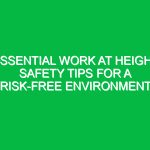Introduction
In the realm of health, safety, and Environment (HSE), the concept of work Safety is paramount. Work Safety refers to the measures and practices employed to protect employees, contractors, and visitors from Hazards in the workplace. These Hazards may include physical dangers, chemical exposures, ergonomic issues, and even psychosocial factors that could lead to injuries or health complications. The relevance of work safety cannot be overstated; it directly impacts the well-being of workers, the productivity of organizations, and the overall Sustainability of environments in which businesses operate.
In this article, we will delve into essential work safety tips designed to prevent critical hazards in the workplace. By understanding and implementing effective safety practices, organizations can create safer work environments that not only comply with legal Standards but also foster a culture of safety that prioritizes employee health and well-being.
Understanding Workplace Hazards
Before we dive into specific safety tips, it’s crucial to understand the types of hazards that can exist in a workplace. Hazards can be broadly categorized into several types:
- Physical Hazards: These include things like machinery, heights, noise, and slippery surfaces that can cause injuries.
- Chemical Hazards: Exposure to harmful substances such as gases, vapors, or liquids that can cause health issues.
- Biological Hazards: These involve exposure to harmful organisms, including bacteria, viruses, and fungi.
- Ergonomic Hazards: Poorly designed workstations and repetitive movements can lead to musculoskeletal disorders.
- Psychosocial Hazards: Workplace stress, harassment, and violence that can affect mental health and well-being.
Recognizing these hazards is the first step towards creating a safer workplace.
Key Work Safety Tips
Implementing effective safety practices can significantly mitigate risks associated with the various hazards mentioned above. Here are essential work safety tips that organizations can adopt to prevent critical hazards:
1. Conduct Regular Risk Assessments
Risk assessments are fundamental to identifying potential hazards in the workplace. Regular assessments allow organizations to evaluate risks associated with specific tasks or processes. This proactive approach helps in developing appropriate Safety Measures.
For instance, a construction site may conduct a risk assessment to identify Fall Hazards and subsequently implement safety harness requirements. This systematic evaluation and documentation are critical in ensuring compliance with safety Regulations.
2. Provide Comprehensive Training
Training is a vital component of Workplace Safety. Employees should receive thorough training on safety protocols, emergency Procedures, and the proper use of Personal Protective Equipment (PPE).
Consider a manufacturing plant where workers are trained on how to operate machinery safely. This training should include potential hazards associated with the equipment, emergency shut-off procedures, and the importance of wearing specific PPE like goggles and gloves.
3. Promote a Safety Culture
Creating a culture of safety within the organization encourages employees to prioritize their safety and the safety of their colleagues. This can be achieved through regular safety meetings, recognition programs for Safe Practices, and open communication about safety concerns.
A personal anecdote illustrates this point: At a previous workplace, we initiated a “Safety Week” where employees could share safety tips, attend workshops, and participate in safety drills. The result was a noticeable decrease in workplace incidents and a heightened awareness of safety protocols.
4. Implement Proper Signage and Communication
Clear and visible signage plays a crucial role in maintaining Workplace Safety. Signs should indicate potential hazards, provide instructions for Safe Practices, and highlight emergency exits.
Consider a chemical storage area that uses clear signage to notify workers of the dangers associated with the materials stored. This proactive communication can significantly reduce the risk of accidents.
5. Use Personal Protective Equipment (PPE)
PPE is an essential line of defense against workplace hazards. Organizations must ensure that employees have access to appropriate PPE and are trained in its proper use.
For example, in a lab setting, employees should wear gloves, goggles, and lab coats when handling chemicals. Regular checks should be conducted to ensure that PPE is in good condition and replaced as necessary.
6. Establish Emergency Procedures
Every workplace should have a comprehensive emergency response plan that outlines procedures for various emergencies, including Fires, chemical spills, and medical emergencies.
Regular drills should be conducted to ensure that all employees are familiar with the emergency procedures. For example, a fire drill can help employees understand evacuation routes and the location of fire extinguishers.
7. Maintain Equipment and Workspaces
Regular Maintenance of machinery and equipment is crucial in preventing accidents. Faulty equipment can pose significant risks to workers.
In an industrial setting, preventive maintenance schedules should be established to ensure that machinery is in good working order. Additionally, maintaining clean and organized workspaces can reduce the risk of slips, trips, and falls.
8. Encourage Reporting of Hazards
Employees should feel empowered to report hazards without fear of reprisal. Establishing a clear reporting process encourages workers to communicate safety concerns, leading to quicker resolutions.
For instance, implementing an anonymous reporting system can help identify potential hazards that may otherwise go unreported.
9. Monitor and Review Safety Practices
Safety practices should be regularly monitored and reviewed to ensure their effectiveness. This includes analyzing incident reports, conducting audits, and soliciting employee feedback on Safety Measures.
For example, a quarterly safety review can help identify trends in workplace incidents and lead to improvements in safety protocols.
10. Stay Informed about Regulations and Standards
Compliance with local, national, and international safety regulations is essential. Organizations should stay informed about changes in regulations and standards to ensure ongoing compliance.
The Occupational Safety and Health Administration (OSHA) in the U.S. sets forth regulations that govern Workplace Safety. Understanding and adhering to these regulations not only ensures compliance but also enhances Workplace Safety.
Real-Life Examples of Safety Success Stories
To illustrate the impact of effective safety practices, consider the case of a manufacturing company that faced numerous incidents related to machinery accidents. After conducting a thorough risk assessment and implementing comprehensive training programs, the company saw a dramatic reduction in accidents.
Through the establishment of a safety culture that encouraged open communication and employee involvement in safety committees, the company was able to foster an environment where safety was prioritized. Over the span of two years, the organization reported a 60% decrease in workplace injuries, demonstrating the tangible Benefits of committing to work safety.
Regulations and Standards
Understanding the regulations governing Workplace Safety is crucial for organizations aiming to foster a safe working environment. In the United States, osha provides guidelines that cover various aspects of workplace safety, including Hazard Communication, personal protective equipment, and emergency preparedness.
Compliance with these regulations not only protects employees but also helps organizations avoid legal repercussions and potential fines. It is important for businesses to regularly review and update their safety practices in alignment with these regulations.
Conclusion
In conclusion, work safety is an essential aspect of the health, safety, and environment domain. By recognizing potential hazards and implementing effective safety practices, organizations can create safer workplaces that protect employees and enhance productivity.
From conducting regular risk assessments to fostering a culture of safety, the tips outlined in this article provide a comprehensive approach to preventing critical hazards. Emphasizing the importance of compliance with safety regulations further reinforces the need for organizations to prioritize work safety.
As we move forward, it is crucial for businesses and employees alike to remain vigilant in their commitment to safety, ensuring that every worker returns home safely at the end of the day. Whether through ongoing training, effective communication, or the use of personal protective equipment, the steps taken today can lead to a safer tomorrow.


